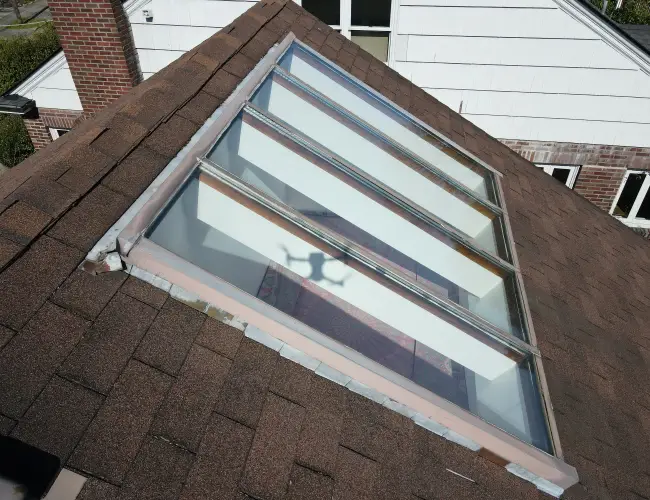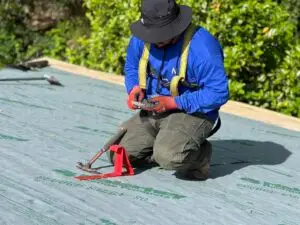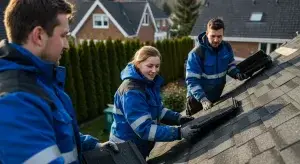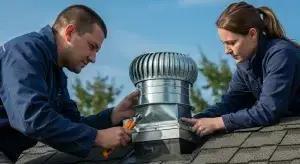While skylights bring light and warmth into your living space, they also have a dark underbelly – leaks. If you have a skylight, look out for tell-tale signs of leaks, such as water stains and discoloration on the ceiling, pooling water (especially after rainfall), swollen or textured areas on the ceiling, peeling paint, rotting wooden elements, and mold or mildew.
But why do these leaks happen? We’ll look at some of the common causes of skylight leaks and how you can prevent them.
1. Incorrectly Installed Flashing
Roof flashing is the metal or waterproof material that is used to seal the edges of the skylight and adhere it to the roof. Even a small mistake in installing the flashing, such as misalignment or improper sealing, can create gaps where water can enter and cause damage to your home.
When the flashing isn’t installed correctly, water can pool around the skylight’s edges and eventually seep inside the house from under the frame.
With newer skylights, where the unit itself is sturdy, most leaks are caused by improper flashing. The type of flashing used also affects the potential for leaks. For example, continuous side flashing creates a vulnerable seam where water is likely to enter. On the other hand, step flashing uses overlapping metal pieces bent at a particular angle that allow water to flow down and away from the sides of the skylight. We advise using continuous side flashing in tandem with step flashing for more robust waterproofing.
The roof itself can also cause the skylight to leak – for example, debris accumulation causes water to pool around the skylight’s edges and eventually find a way inside.
Regularly inspect the seals and flashing around your skylight, and if you notice any damage or misalignment, have them replaced as soon as possible. It costs between $75 and $250 to reseal a skylight, and you should always hire a certified roofing contractor instead of going for temporary solutions.
On the other hand, replacing the flashing for a leaking skylight can cost between $150 and $800, depending on how extensive the damage is and how accessible the roof is. And while that may seem like an unnecessary expense, it’s more cost-effective than continuously managing recurring leaks and fixing water damage.
2. Aging Materials
Over the years, the skylight’s materials (such as seals, glass, and framing) deteriorate – and not even the best skylights are immune to this. And in the Pacific Northwest climate, especially, this aging process is expedited. Here are some things that can happen:
- The seals or weather stripping around the skylight can crack, become dry, or lose their adhesiveness. This creates paths for water to penetrate.
- Older skylights can develop cracks or bubbles in the glass, allowing water entry.
- The metal frame can deteriorate from corrosion. Many lower-quality materials may rust over time and weaken the skylight’s overall structure.
The professional opinion is that skylights more than 25 years old should be replaced. This would prevent both leaks and energy inefficiency, as newer skylights are manufactured with better insulation, enhanced seals, and more durable materials. In addition, regular inspections every two years can help catch any issues early on.
We also recommend installing new skylights when undertaking roof replacement or maintenance projects, as this helps the skylight integrate better with the roof and costs less than installing it separately.
3. Design Flaws
Sometimes, leaks are caused by the design of the skylight itself. If you use a skylight designed for shingle roofs on a metal roof, it will lead to improper adhesion, a premature failure of the seals, and greater vulnerability to cracks and leaks. Moreover, if the opening of the skylight is too large, too small, or not properly integrated with the roof (such as due to incompatible materials), the seal will be stretched too thin or not attached properly.
Another important aspect to keep in mind is that buildings settle with time. And if your skylight is not flexible enough to accommodate small shifts in the roof’s structure, gaps can form that nullify the skylight’s waterproofing. Here’s a quick overview of the common design issues in skylights:
Cause | Description | Preventive Measure |
Oversized Openings | Excessive gaps or improperly sized openings affect seal integrity | Precise measurements and custom-fit units |
Incompatible Materials | Mismatch between skylight and roof materials | Use manufacturer-recommended materials |
Lack of Flexibility in Design | Failure to account for building movement | Install flexible roof flashing |
4. Poor Insulation
Sometimes, what appears to be a leak may not always be water penetrating from outside the home. When the skylight is not properly insulated, especially in cold and damp climates, the temperature difference between the cool exterior and the warm interior can cause condensation on the inside surfaces of the skylight. This is especially common in humid areas of the house, such as bathrooms, kitchens, and laundry rooms.
Many homeowners fall into the trap of misdiagnosis and go for expensive leak repairs when all they need to do is fix the insulation. Over time, this condensation can drip and cause mold, water stains, and structural damage.
Improper insulation can also cause warm air from the house to escape outside and then freeze, forming ice dams around the skylight’s edges. These then melt and leak down during warmer months.
To counter this issue, many skylights come with double or triple panes to improve insulation. You can also add additional insulation around the skylight, add anti-fogging products to the skylight’s surface, use dehumidifiers, or add ventilation (such as ceiling fans or portable fans) in more humid rooms.
For older skylights, we recommend upgrading to modern units with better built-in insulation. This is usually more cost-effective than retrofitting added insulation around older installations.
5. Clogged Drainage Channels
Did you know that a clogged drainage system is often the culprit in many ‘mysterious’ leaks reported by homeowners? Skylights are designed with built-in drainage called weep holes that drain water away from the skylight. And in Seattle’s windy and damp climate, these drainage channels can get blocked with debris, leaves, twigs, dirt, and even bird droppings.
This causes water to pool and force its way past the seals, and the water weight also puts increased pressure on the skylight, which causes cracks and the seal to wear out.
To make sure there’s no clogging, it’s important to clean the drainage channels, and even an annual hosing down can make a big difference. Use a mild soap and water solution to clean the skylight on a regular basis, and for plastic or acrylic skylights, use non-abrasive cleaning liquids to prevent scratches.
Note: Sometimes the weep holes are installed upside down – an installation error made when the job isn’t handled by professional roofing contractors – and this can make water stand instead of draining away.
6. Environmental Factors
Even though Seattle’s climate is moderate most of the year, there are seasons of heavy rainfall, windstorms, and heavy snow. These weather extremities can take a toll on even the most sturdy and well-installed skylights.
- Prolonged rainfall means that water is coming down at a rapid pace. This allows water to force its way inside and exploit even small imperfections in the seal.
- Strong winds can blow rainwater into any small gaps around the skylight.
- Even though Seattle doesn’t get intense sunlight, UV radiation can still wear out seals and flashing over time.
- Skylight glazing can also develop cracks from impact damage (such as hail) or thermal fluctuations, allowing direct water entry.
- When the accumulated snow on the roof or around the skylight melts, it can find gaps around the skylight and make its way inside.
To prevent environmental damage, there are a few things you can do. Use a roof rake to regularly remove accumulated snow – this prevents ice dam formation and water infiltration. Check your attic’s insulation and ventilation to maintain a consistent roof temperature. Also, choose skylights that are designed for challenging climates and make sure they’re installed with robust flashing.
After extreme weather conditions such as hail storms and heavy rain or snow, inspect the skylight for cracks, holes, or broken seals that could allow water to leak inside. You could also schedule an inspection before any anticipated weather extremes to make sure your skylight is in good condition and ready to handle the stress.
While many environmental factors cause leaks, the most common is rainfall – especially in Seattle’s damp climate. You can also diagnose the severity of the leak by its relationship with the magnitude of rainfall. For example, minor leaks become visible only during heavy rainfall, while serious leakage issues become apparent even after a light rain.
Distinguishing leaks from condensation
You can distinguish condensation from true leaks based on the pattern and timing of the drips. Condensation usually happens during rapid temperature fluctuations, such as in winter months, while leaks often coincide with rainfall.
Another indication of condensation vs true leaks is that condensation appears uniformly across the glass surface of the skylight, while leaks occur at specific points along the skylight’s waterproofing.
What Should You Do Now?
Call in a professional the moment you discover leaking skylights. While some maintenance tasks like cleaning drainage channels and removing accumulated snow can be done by informed homeowners, other repair tasks, such as seal repair or flashing replacement should be left to the experts. We also recommend combining roof and skylight inspections for more comprehensive care.
At NearMe Roofing Company, we offer comprehensive warranties, flexible financing, instant quotes, and professional installations and repairs that will give you peace of mind and keep your home safe for decades. Contact us today for a free roof inspection!





